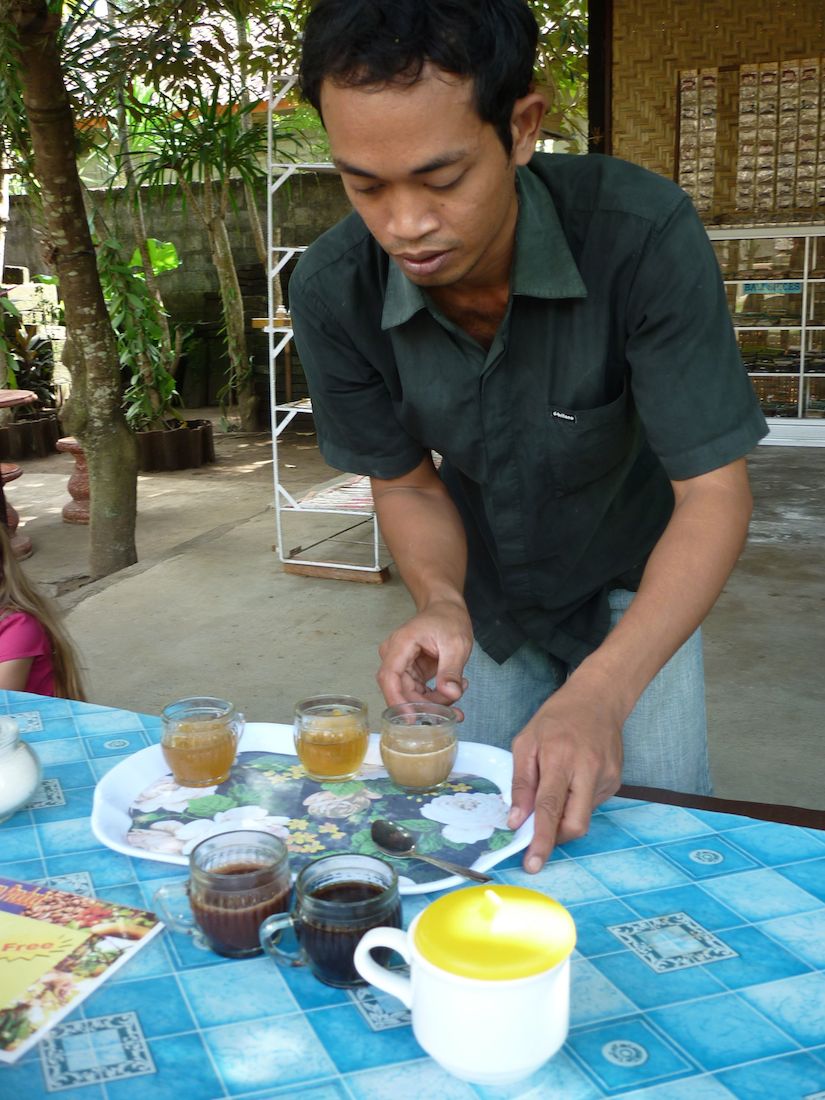Facing The Feces Factor: Tasting My First Cup Of Kopi Luwak Coffee

My first cup of Kopi Luwak coffee, sometimes better known as “cat poo coffee” or the rarest beverage in the world, was a memorable introduction into the highly envious world of extreme luxury, though this tasting occurred far outside the confines of the dining room of a fine-dining restaurant in Hong Kong or New York where cups of Kopi Luwak can run upwards of $50 (or $600 if you wanted to purchase a pound of these coveted beans).
In my case I was sitting at a picnic table covered with a blue-checkered tablecloth near the outskirts of the Indonesian jungle with my husband, Kurt, who had also noticed a hyperactive mongoose pacing in a cage nearby. It seemed rather random, but we were in Southeast Asia where we didn’t understand the local pet protocol.
We were far more focused on sipping the many varieties of teas and coffees offered by one of the hosts of a family-owned coffee compound outside of Ubud, Bali. After having toured the grounds along with our kids, we had been invited to the tasting.
However, we soon learned that the mongoose was actually a closely related animal called a civet, and it was not just an anxious pet ready for a romp in the rainforest. At this particular compound, the family produced a highly prized coffee, Kopi Luwak, which is processed in the stomach of the civet. The coffee farmers feed the beans or “coffee cherries” to the civet, and then the enzymes and acids in the animal’s stomach essentially marinate and break down the bean, thereby eliminating bitterness and creating the most expensive coffee beans in the world.
The catch: the only way to get the processed beans is by waiting for the civet to release them into the wild. Yes, until they defecate. Once this has happened, someone gets to pick the beans from the dung and remove the outer layer of the bean, so it is finally ready to be roasted. Our host explained this to us and gave us a flyer to read.
Frankly, it sounded like something that Eddie made up. Like any five-year-old, most of his revelations and stories involved poop, farts, boogers or any other product that shot or drained out of an orifice. Kurt and I looked at each other, considering the reality of this coffee. Our host offered each of us a cup.
“How about some Fecal Folgers?,” “A tall cup of nonfat, no foam turds, please,” “Well, I prefer a grande carmel macchiato from Starbutts.” It was too easy to make jokes, but should we drink it? Our dilemma was whether to be culturally sensitive and embrace the offering or to come off as lame, mistrustful tourists.
Kurt shrugged his shoulders and then both of us picked up the cups. If ever there was a one-of-a-kind cultural experience, this was it. I swished the coffee around in the cup. It looked like regular coffee — no suspicious residue readily visible.
Time to down the dung. It was really quite smooth, almost creamy. Actually, it was delicious. The host smiled and nodded as if he knew what we were thinking. He then gave cups to the kids. I almost put my hand out to halt him, but then I stopped. Normally, I wouldn’t let the kids, who were five and three years old, drink anything with caffeine, but what the hell? Why not?
Kurt and I drank the stuff. Plus, we hadn’t brought the kids to Bali to drink rainbow sparkle smoothies with Mickey and Minnie. At worst, we’d have a night of family bonding and barfing.
Both Eddie and Kasey grinned at each other after they drank the beverage. Part of the thrill, I’m sure, was that they were consuming something they knew was for adults. We also avoided telling them about the feces factor. However, we did inform them that they were drinking a “special” coffee.
Special indeed. In fact, coffee connoisseurs from around the world want these expensive coffee beans, which can cost hundreds of dollars per pound.
They also note that Kopi Luwak has seen a growth in popularity in recent years decades after almost disappearing as a beverage in Indonesia. Although historically Kopi Luwak has experienced various trendy times, especially with foreigners living in Indonesia. Dutch colonists consumed the Kopi from the 1600’s to the end of their rule at the beginning of World War II. Then, during the war, while Japanese soldiers occupied Indonesia, they developed a taste for the turdy beans.
And who can blame them? At the moment, I really couldn’t think of anything I’d rather do than hang out at Balinese family-owned coffee compound in the jungle and drink poop coffee with my own family and a hyper civet.
By Steph Glaser

ABOUT THE AUTHOR
 A freelance writer, teacher and traveler, Steph Glaser studied in the Netherlands during college and then updated a chapter on the country for the now defunct budget travel guide series, The Berkeley Guides. Additionally, as an American exchange teacher in Australia, she became fluent in Aussie teenage slang courtesy of her high school students. Currently, Glaser lives with her family in Colorado where she teaches public speaking and writes about her travel blunders for her blog, TravelOops.com.
A freelance writer, teacher and traveler, Steph Glaser studied in the Netherlands during college and then updated a chapter on the country for the now defunct budget travel guide series, The Berkeley Guides. Additionally, as an American exchange teacher in Australia, she became fluent in Aussie teenage slang courtesy of her high school students. Currently, Glaser lives with her family in Colorado where she teaches public speaking and writes about her travel blunders for her blog, TravelOops.com.
